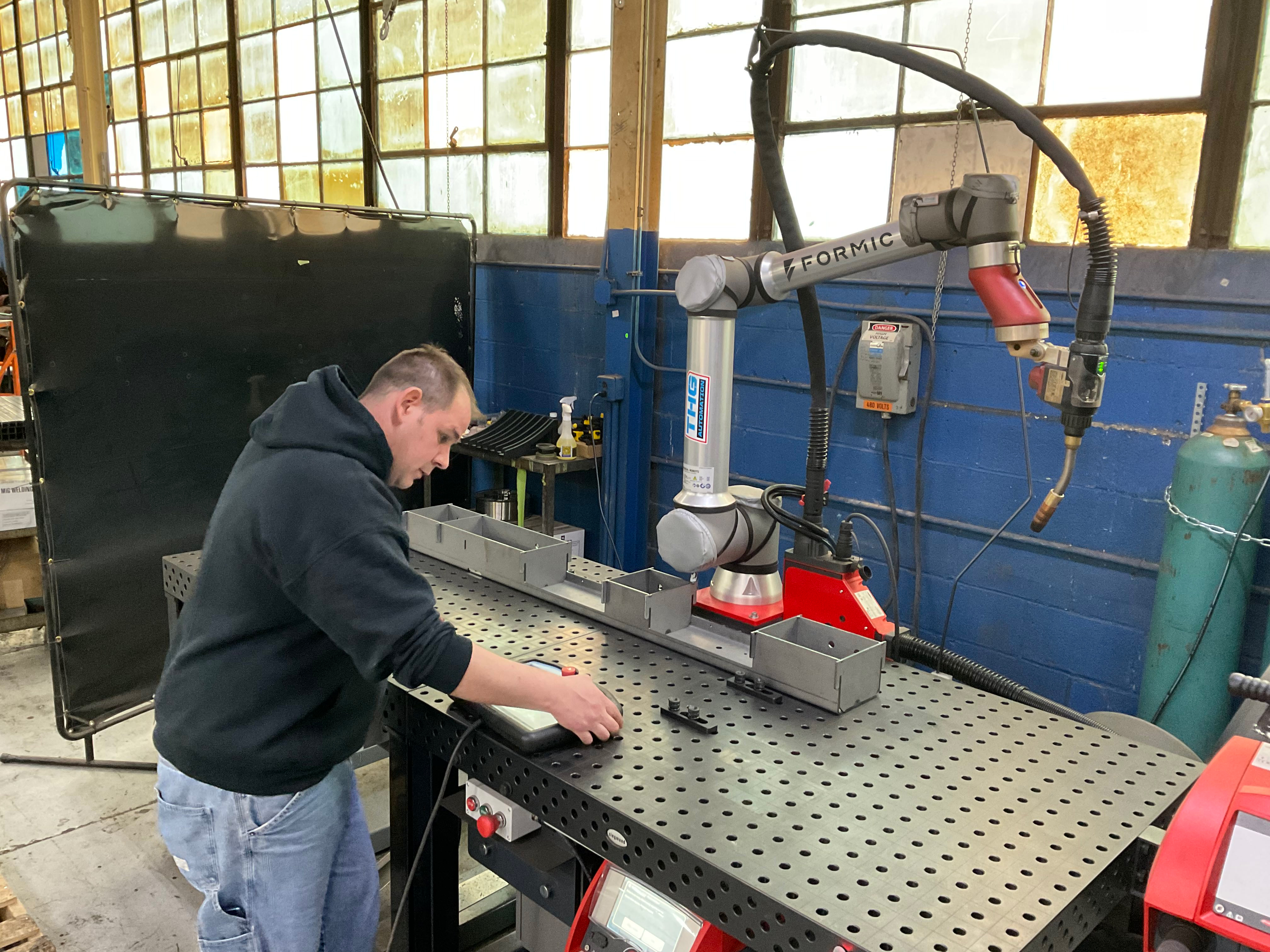The Complete Guide to Robotic Automated Welding
Table of Contents
- What is Cobot Welding?
- Collaborative welding vs manual welding and traditional automation
- Benefits of cobot welding
- How do my welders work with a cobot?
- Why should I invest in a cobot welder?
- Why choose the Formic Weld?
The welding industry is facing a significant shortage of skilled workers, with the American Welding Society predicting a deficit of around 400,000 skilled welders in the U.S. by 2024. This shortage is due to a combination of factors such as the retirement of baby boomers, younger generations favoring college over trades, and a surge in demand for skilled tradespeople post-pandemic.
Adding to this challenge, the National Association of Manufacturers (NAM) reports that almost 81% of manufacturers are unable to find enough skilled welders to meet their needs. The industry’s continued growth and demand for skilled labor make it increasingly difficult for companies to find qualified welders to meet production demands.
Fortunately, a solution to this labor shortage is emerging: cobot welding.
This innovative technology combines the skill of human welders with the precision and efficiency of robots to transform the welding industry. In this article, we will explore the benefits and applications of cobot welding, and how it can address the challenges faced by the welding industry. By leveraging the advantages of a cobot welder, companies can improve their productivity, reduce costs, and overcome the labor shortage in the welding industry.
What is Cobot Welding?
Cobot welding refers to the use of collaborative robots, or cobots, to automate certain welding processes. A cobot welder consists of a robotic arm, welding torch kit, power source, cooling system, and a way to program the robot. The robot can be mounted on a welding table, cart, or magnetic mount, depending on the specific application.
The key advantage of a cobot welder is that it allows human welders to work alongside the robot, rather than being replaced by it. This collaboration between human and machine brings together the unique skills of both to create a more efficient and precise welding process.

Cobot welding has already been successfully employed in a wide range of industries, including automotive, aerospace, and electronics. By leveraging the benefits of cobot welding, companies can improve the quality of their welds, increase productivity, and reduce labor costs. In the following sections, we will explore in detail the advantages and applications of cobot welding.
Collaborative welding vs manual welding and traditional automation
So how does cobot welding compare to traditional automation and manual welding?
To get a good understanding of the strengths and weaknesses of different welding approaches, let’s delve into a quick comparative analysis. In this table, we explore the key aspects of cobot welding, traditional automation, and manual welding. By examining factors such as mix, volume, robotics skill, investment, and human presence, we aim to provide insights into which method may be the most suitable for specific welding applications.
So, let’s take a closer look at how these approaches stack up against each other in the world of welding.
|
Best Fit |
Traditional Automation |
Collaborative Welding |
Manual Welding |
|
Mix |
Low |
Moderate to High |
High |
|
Volume |
High |
Low to Moderate |
Low |
|
Robotics Skill |
High |
Low |
None |
|
Welder Present |
No |
Yes |
Yes |
|
Investment |
High |
Moderate |
Moderate |
Industrial robotic welding offers high speed and productivity, making it an efficient choice for large-scale production. However, its inflexibility necessitates a dedicated welding cell. While it proves advantageous for handling substantial batch sizes, implementing robotic welding can be costly and demands a skilled robot operator for programming.
Cobot welding offers a balance between the speed and accuracy of industrial robotic welding and the flexibility and adaptability of manual welding, making it ideal for low-volume, high-mix production runs and applications that require human collaboration.
Manual welding requires skilled welders and can be dangerous if safety precautions are not taken. It excels in scenarios with a high mix of welding tasks but becomes less efficient as batch sizes increase.
Benefits of cobot welding
Cobot welding offers several significant advantages over traditional manual welding. These include:
- Quality: Unlike human workers, who may tire and lose concentration over time, welding cobots consistently deliver the same high-quality work, determined by their programmed parameters.
- Productivity: Human workers naturally slow down over time, while welding cobots can continue to produce the same quantity of output given a specific programmed task, regardless of how long it takes.
- Efficiency: Welding cobots can perform repetitive welds, freeing up human workers to focus on more specialized welding requirements.
- Safety: Welding poses several safety risks, including toxic fumes, eye injuries, and burns. By placing a welding cobot on the front line and having operators work from a safe distance, companies can eliminate many of these safety concerns.
In addition to these benefits, welding cobots are also easy to use and maintain. Existing workers can be trained to program, troubleshoot, and repair them, upskilling them for more specialized tasks. Welding cobots are cheaper than traditional industrial robots and require less space, making them an attractive option for companies looking to improve their welding operations while keeping costs under control.
By leveraging the benefits of robotic welding with a cobot, companies can improve the quality and consistency of their welds, increase throughput, reduce labor costs, and create a safer working environment.
How do my welders work with a cobot?
When it comes to cobot welding, it’s important to note that these collaborative robots are designed to work alongside human welders, not replace them. In fact, experienced welders are still needed to “train” or program the cobot and ensure the quality of the final welds.
By using cobot welding, your skilled workers can spend less time manually repeating simple welds and more time focusing on more complicated welding tasks. This can greatly increase overall productivity and efficiency, as well as free up your welders’ time to work on more valuable or specialized tasks.
Luckily, learning how to program a cobot is a relatively quick process, taking qualified welders less than a day to master. Some cobots, like the ones installed by Formic, even come with a programming flange that allows operators to manually move the robotic arm during programming to set points and teach it what to do, eliminating the need for complex programming skills. With this technology, your welders can easily transition into working with a cobot and improving your welding operations.
Why should I invest in a cobot welder?
In this day and age, there are a myriad of reasons to invest in a cobot welding system to automate welding processes. Investing in a cobot welder can significantly enhance the productivity and efficiency of welding operations. Cobots are designed to work alongside human operators, providing assistance with welding tasks, while also ensuring precision and consistency in the weld quality. This collaborative approach can reduce the physical strain on human workers and free them up to focus on more complex aspects of the welding process. Additionally, cobots are generally easier to program and integrate into existing workflows compared to traditional industrial robots. This makes them a practical and cost-effective solution for businesses looking to adopt automation in their welding operations. With the capability to easily adapt to different tasks, cobot welders are a versatile and valuable asset that can improve the overall quality and efficiency of welding processes.
Obviously, the initial expense of purchasing the equipment and training staff cannot be avoided. So how long will it take to recoup your costs?
That depends on your volume of work and how much you utilize the cobot on a daily basis. Generally, however, most companies find it takes between 1 and 3 years to pay for itself. Unless you use Formic's RaaS model.
Why choose the Formic Weld welding package?
When buying directly from a typical equipment vendor or manufacturer, the responsibility of operation usually falls squarely on your shoulders. This includes buying the equipment and then being responsible for tasks like unloading, setup, training, and continuous maintenance. But with Formic, the experience is refreshingly different.
You pay nothing up front for the system, and Formic’s team of experts ship and unload the system at your location, and guarantee everything is set before activation. It's natural that some fine-tuning may be required to achieve optimal production rates, so Formic's expert technicians adjust all necessary settings. The commitment doesn't end there. Formic remains dedicated, offering post-launch support and vital training to all team members involved, ensuring a flawless integration of the new automation into your current operations.
Is cobot welding right for my business?
There’s never been a better time to look into modernizing and adding automation to your welding practices.
Schedule a call with us to learn more about how welding cobots can:
- help you keep up with the welding demands of your business
- increase your welding quality, productivity, and efficiency
- provide high-quality working conditions and opportunities for current and future staff
Find out which robotic welding is right for you
How to Automate Welding
Automating a welding process involves a series of strategic steps designed to optimize efficiency, reduce costs, and enhance quality. Here's a step-by-step guide to navigating this complex yet rewarding transition.
- Identify the Application: Understand the specific sector—be it manufacturing, automotive, aerospace, or another industry—where the automated welding will be applied.
- Evaluate ROI: Perform a thorough analysis of the potential return on investment, considering key factors such as efficiency gains, labor cost reduction, and waste minimization.
- Choose Robotic Technology: Decide between industrial robots for high-speed tasks and collaborative robots (cobots) for more intricate tasks that require human-robot collaboration.
- Welding Type: Identify the specific type of welding required for your application, such as MIG, TIG, or spot welding.
- Payload Capacity: Ensure the chosen robotic technology can handle the weight and dimensions of the materials you'll be working with.
- Ease of Programming: Opt for a robot or cobot with an intuitive user interface for quick setup and seamless operation.
- Consult Experts: If needed, consult with experts like Formic Technologies, who offer comprehensive solutions from system setup to ongoing maintenance.
Automating your welding process is a nuanced operation that, when executed correctly, offers significant benefits in efficiency, quality, and cost-effectiveness. Following this guide and potentially partnering with full-service providers like Formic Technologies can make the transition smooth and successful.
Download the Free Guide: How to Get Started with Robotic Automation
Automating with Formic, the only question manufacturers need to ask themselves is: what repetitive manual tasks can be automated in my facility right now?


